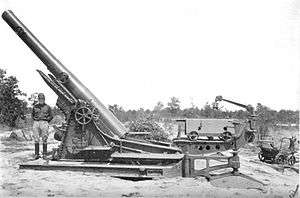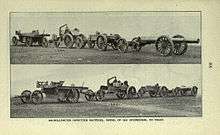M1918 240 mm howitzer
The M1918 240 mm howitzer was a copy of a French World War I siege howitzer, manufactured in the U.S. to specifications of the U.S. Army.[1]
| M1918 240 mm howitzer | |
|---|---|
 | |
| Type | Howitzer |
| Place of origin | United States |
| Service history | |
| In service | 1920s–1943 |
| Used by | United States |
| Production history | |
| Designed | 1917–1920s |
| Produced | late 1920s |
| No. built | 330 |
| Specifications | |
| Mass | Combat: 41,296 lb (18,732 kg) |
| Length | 16 ft 6 in (5.03 m) |
| Crew | 12 |
| Shell | HE projectile: 345 lb (156 kg) Bagged charge: 36.5 lb (16.6 kg) |
| Caliber | 240 mm (9.45 in) |
| Breech | Interrupted screw |
| Recoil | Hydro-pneumatic |
| Carriage | steel carriage aiming box, which traverses on a ground emplacement base |
| Elevation | -10° to +60° |
| Traverse | 10° right or left. |
| Rate of fire | Sustained: 12 rounds/per hour |
| Muzzle velocity | 1,700 feet/s (518 m/s) |
| Maximum firing range | 9.3 miles (15 km) |

History
When the United States entered World War I, the U.S. Army had no modern heavy artillery that could be moved by roads. To speed the process of filling this shortcoming, the U.S. Army decided to adopt a foreign design from its Allies for manufacturing in the U.S., and set up a commission for this purpose. The decision was to adopt a 280 mm howitzer produced by the French armament firm Schneider, which was in service with the French Army during the war as the Mortier de 280 modèle 1914 Schneider. However, the U.S. Army wanted the original French cannon in a 240 mm caliber. The Schneider 280 mm cannon actually predated World War I and was originally designed and produced under a contract from the Imperial Russian Army. As requested by the U.S. government, Schneider scaled down their original 280 mm cannon and sent drawings and technicians to the U.S. to set up production as the 240 mm howitzer M1918. The first cannon was not ready for proof testing until 1918 after the war had ended. When firing its first proof shot it exploded, and production was halted while the U.S. Army and Schneider investigated the reason behind the failure and redesigned the weapon. This took until the mid-1920s to complete. It was not until the mid-1920s that production restarted with 330 M1918s being produced. The M1918 became the heaviest mobile artillery piece in the U.S. Army until its replacement, the 240 mm howitzer M1, was introduced in 1943. Although a lot of work was done by the U.S. Army engineers on the M1918 design, it never was considered a suitable cannon, but for lack of funding from Congress, they had to make do with the French cannon design. It is unknown whether any M1918s saw combat service during World War II, but it is unlikely due to its range and vulnerability to counter battery fire. In 1923 twelve of these weapons were on a ship bound for the Philippines when the Washington Naval Treaty went into effect, prohibiting additional fortifications in the Pacific. The ship was ordered to deliver the weapons to Hawaii instead. Thus, at least 12 of these weapons were present on fixed mountings on Oahu during the attack on Pearl Harbor.[2][3][4][5]
Description
The M1918 was similar to most mobile siege cannons of World War I. With the exception of the caliber and a few minor details, it was an exact copy of the French 280 mm howitzer. It was moved in four large sections by heavy tracked ten ton tractors. There was also a fifth large load for the erection of the frame and other items needed to assemble the four main cannon components from their specialized transport wagons. The total weight of the five loads was 21.5 tons and was limited to a road speed of only 5 miles per hour. The first load was the 16-1/2 foot cannon barrel, the second load was the recoil mechanism, the third load was the carriage-aiming mount and the fourth the ground base. After a site was chosen, installation began with the handheld-tool digging of a large recoil pit, and then assembly of an iron beam erection structure over the emplacement pit. Under the best conditions, installation required four to six hours.[6][7][8]
See also
Footnotes
- Ordnance Department Document No. 2033 Handbook of Artillery, p. 307, May 1920, Government Printing Office, Washington
- 240 mm howitzer thread on Corregidor - Then and Now forum
- "notes page". Archived from the original on 2011-01-21. Retrieved 2010-11-07. Site cdsg.org notes Prepared 240 mm Howitzer Positions in Hawaii: 12 positions for 240mm howitzers on modified mobile M1918 carriages were prepared in 1920. Eight more positions were added during 1938-1945, although there only 12 of these weapons were on hand.
- Berhow, pp. 192-193, 220-221
- 240 mm howitzer positions on Oahu at CDSG website
- "Dynamite On Wheels" , April 1942, Popular Science Popular Science, April 1942, p. 64
- US Army 1920 "Handbook of Artillery" page 305 shows recoil pit location
- US Army 1920 "Handbook of Artillery" page 311 shows erection frame
References
- GlobalSecurity.org 240 mm M1
- The Illustrated Encyclopedia of 20th Century Weapons and Warfare, Vol 7, page 779, editor Bernard Fitzsimons, Purnell & Sons Ltd 1967/1969
- Berhow, Mark A., Ed. (2004). American Seacoast Defenses, A Reference Guide, Second Edition. CDSG Press. ISBN 0-9748167-0-1.
External links
| Wikimedia Commons has media related to 240mm M1918 howitzer. |
- "Handbook of Artillery" US Army Ordnance Document 2033, published 1920, pages 300 to 320, highly detailed document
- "Dynamite On Wheels" , April 1942, Popular Science one of the few World War II articles on the 240 mm M1918 with rare photos
- Biggest Guns On Wheels July 1945 Popular Science article which compared the 240 mm howitzer M1918 to the cannon that replaced it, the 240 mm M1 howitzer
- TM 9-2005, December 1942 Pages 89–93 describe the 240mm howitzer